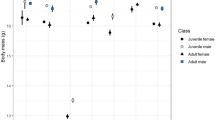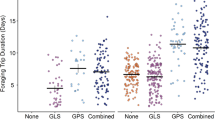Abstract
Concern about the effects of habitat modification on the natural movements and behavior of amphibians has led researchers to devise several methods to follow individual animals as they migrate among seasonal resources; one such method is the surgical insertion of radiotransmitters. Intracoelomic implantation has come into general use despite the relative lack of specific procedural guidelines and information about the effects of transmitter insertion and removal. The author outlines the surgical implantation procedures used on a small amphibian (gray treefrog) and provides insight into the effects of multiple major surgical invasions on the long-term survival of amphibians. Multiple survival surgeries were successful in this study and may be an alternative to euthanasia in some instances.
This is a preview of subscription content, access via your institution
Access options
Subscribe to this journal
We are sorry, but there is no personal subscription option available for your country.
Buy this article
- Purchase on Springer Link
- Instant access to full article PDF
Prices may be subject to local taxes which are calculated during checkout


Similar content being viewed by others
References
Stouffer, R.H., Jr., Gates, J.E., Hocutt, C.H. & Stauffer, J.R., Jr. Surgical implantation of a transmitter package for radio-tracking endangered hellbenders. Wildl. Soc. Bull. 11(2), 384–386 (1983).
Smits, A.W. Activity patterns and thermal biology of the toad Bufo boreas halophilus. Copeia 1984(3), 689–696 (1984).
Sinsch, U. Temporal spacing of breeding activity in the natterjack toad, Bufo calamita. Oecologia 76(3), 399–407 (1988).
Werner, J.K. A radiotelemetry implant technique for use with Bufo americanus. Herpetol. Rev. 22(3), 94–95 (1991).
VanNuland, G.J. & Claus, P.F.H. The development of a radio tracking system for anuran species. Amph. Rept. 2(2), 107–116 (1981).
Kingsmill, S. How to track a toad: attach a designer backpack and radio, of course. Int. Wildl. 21(1), 29 (1991).
Fukuyama, K., Kusana, T. & Nakane, N. A radio tracking study of the behavior of the frog Buergeria buergeri (Rhacaphoridae, Amphibia) in a breeding stream in Japan. Jap. J. Herpetol. 12(3), 102–107 (1988).
Rathbun, G.B. & Murphy, T.G. An evaluation for a radio-belt for ranid frogs. Herpetol. Rev. 27(4), 187–189 (1993).
Oldham, R.S. & Swan, M.J.S. The effects of ingested radiotransmitters on Bufo bufo and Rana temporaria. Herpetol. J. 2(3), 82–85 (1991).
Plummer, M.V. & Congdon, J.D. Radiotelemetric study of activity and movements of racers (Coluber constrictor) associated with a Carolina bay in South Carolina. Copeia 1994(1), 20–26 (1994).
Mulcahy, D.M. & Esler, D. Surgical and immediate post release mortality of Harlequin ducks (Histrionicus histrionicus) implanted with abdominal radio transmitters with percutaneous antennae. J. Zoo Wildl. Med. 30(3), 397–401 (1999).
Guynn, D.C., Jr., Davis, J.R. & von Recum, A.F. Pathological potential of intraperitoneal transmitter implants in beavers. J. Wildl. Manage. 51(3), 605–606 (1987).
Gray, M.J., Miller, D.L. & Smith, L.M. Coelomic response and signal range of implant transmitters in Bufo cognatus. Herpetol. Rev. 36(3), 285–288 (2005).
Bradford, D.F. Temperature modulation in a high-elevation amphibian, Rana muscosa. Copeia 1984(4), 966–976 (1984).
Madison, D.M. The emigration of radio-implanted spotted salamanders, Ambystoma maculatum. J. Herpetol. 31(4), 542–551 (1997).
Wright, K.M. Surgery of amphibians. Vet. Clin. North Am. Exot. Anim. Pract. 3(3), 753–759 (2000).
Wright, K.M. in Amphibian Medicine and Captive Husbandry (eds. Wright, K.M. & Whitaker, B.R.) 111–121 (Krieger Publishing Co., Malabar, FL, 2001).
Richards, S.J., Sinsch, U. & Alford, R.A. in Measuring and Monitoring Biological Diversity: Standard Methods for Amphibians (eds. Heyer, W.R. et al.) 155–158 (Smithsonian Institution Press, Washington, DC, 1994).
Downes, H. Tricaine anesthesia in amphibia: a review. Bull. Assoc. Rept. and Amphib. Vet. 5(2), 11–16 (1995).
Bennett, R.A. in The Veterinary Clinics of North America—Exotic Animal Practice: Soft-Tissue Surgery (ed. Bennett, R.A.) 563–585 (W.B. Saunders Co., Philadelphia, 2000).
Seitz, A. Faller-Doepner, U. & Reh W. in Wildlife Telemetry: Remote Monitoring and Tracking of Animals (eds. Priede, I.G. & Swift, S.M.) 484–489 (Ellis Hornwood, Chichester, UK, 1992).
Acknowledgements
Funding for this research was provided by a TWA Fellowship. The author thanks R. Semlitsch for supplies provided by NSF grant DEB-023 9943; J. Millspaugh for access to field sites; R. Mahan, J. Haynes, D. Johnson, and G. Johnson for assistance in capturing individuals; and R. Semlitsch, M. Dyson, and T. Rittenhouse for helpful comments on an early draft of the manuscript and discussions about surgical methods.
Author information
Authors and Affiliations
Ethics declarations
Competing interests
The author declares no competing financial interests.
Rights and permissions
About this article
Cite this article
Johnson, J. Success of intracoelomic radiotransmitter implantation in the treefrog (Hyla versicolor). Lab Anim 35, 29–33 (2006). https://doi.org/10.1038/laban0206-29
Received:
Accepted:
Issue Date:
DOI: https://doi.org/10.1038/laban0206-29



